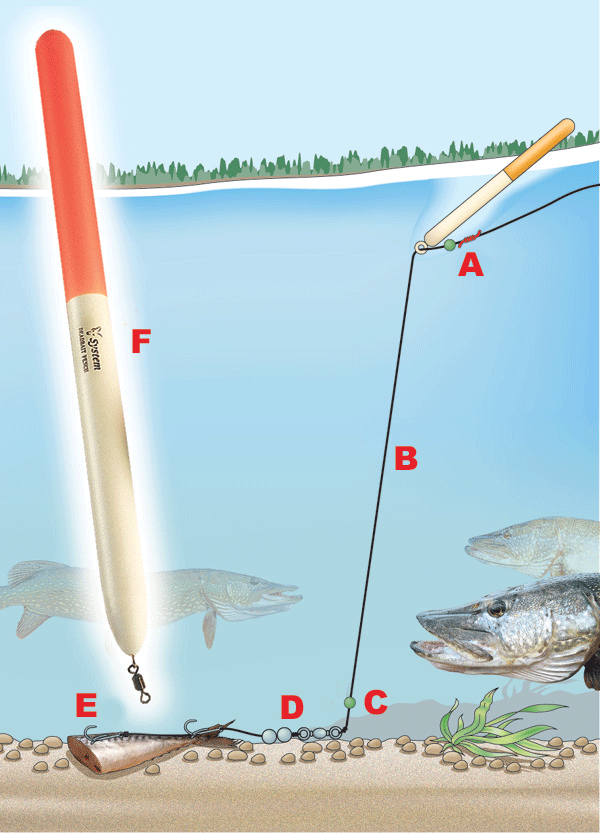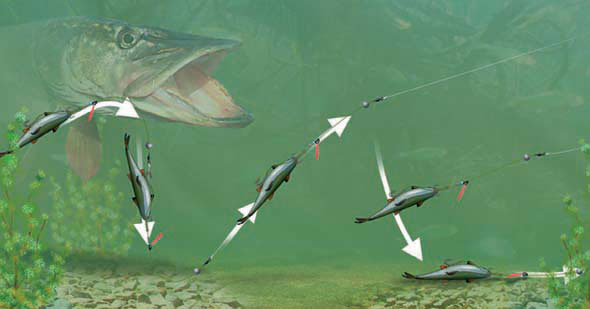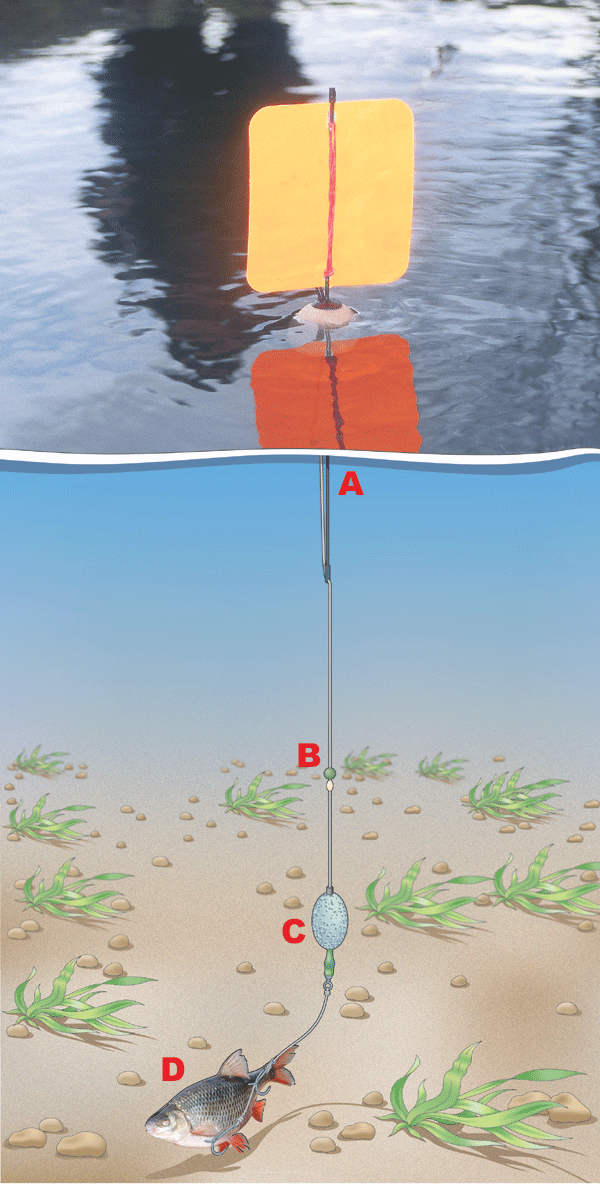Pike fishing rigs | Drifter float
Pike fishing season is here but what rig will you be using this winter? As pike turn off from the idea of chasing a lure around the most logical choice is to turn your attention to deadbaiting. We’ve gone to current Drennan Cup champion Dai Gribble on what his preferred choice of pike fishing rig is.
One of the most exciting ways of catching pike at this time of year is to drift deadbaits under a float.
This allows you to cover lots of water and depths, and you can search out areas you might not be able to access from the bank or boat with other styles of pike fishing.
The key to it is a rather unique-looking float made for the job. Despite looking rather complex, this set-up is actually quite straightforward to put together and fish with.
In years gone by the biggest obstacle to fishing a drifting float effectively was getting your mainline to float, but now there is a plethora of floating braided lines available that are all perfect for the task.
Braided lines have another big advantage over mono in that they have very little stretch. This enables you to set the hooks even when the drifting float is 100 yards or more out from the bank.
Watching any pike float disappear is exciting enough, but there is something extra special about watching a float that has travelled across many yards of water sink from sight. Give it a go!
A) TRACE CHOICES
A trace is tied to the braid mainline using a five-turn grinner knot.
The trace is chosen to match the size of the bait – the bigger the bait, the bigger the hooks I use. With small baits such as a smelt or roach I choose size 8 trebles, going up to size 4 for a larger herring or mackerel deadbait.
B) DEPTH TO FISH
It helps if you have some idea of the depth of the water you are going to drift over. I like to set the float so that the bait is about 18ins from the bottom, as generally pike are lying up on or near the lakebed.
If you find the bait is catching on weed or on the bottom, wind in and reduce the depth. Similarly, if the float has travelled to the end of the drift without catching on anything you can increase the depth a little each cast.
C) SIZES TO USE
The float’s buoyancy comes from the foam, egg-shaped part of the float, and different sizes of egg allow you to use different size weights and baits.
For small baits up to about 3oz I use the smaller egg. I use a drilled bullet as weight and stop it with a small rubber bead to protect the knot.
You want the combined weight of the drilled bullet and deadbait to cock the float with the vane standing just clear of the water. Too much weight and the vane will be partially submerged, too little and it will blow over rather than move in the wind.
D) ADJUSTING THE DRIFT SPEED
The main part of the drifter float is a vane attached to a long stem. Adjusting the elastic band holding it in place can set the degree of curve in the vane. The degree of curve dictates how fast the float will travel – the greater the curve, the more the wind will catch it and the faster it will drift.
E) ATTACHING THE FLOAT
To set up a drifter float, first thread a rubber float stop on to the braid. This enables you to set the float at your chosen depth.
The float is attached by threading the braid through the long piece of tubing with a small float at the top.
The drifting part of the float is attached to the bottom end of the tubing. This means that when you strike, the float will offer little resistance and ‘fold’ over, much like a normal waggler float.
Top five lures for perch fishing with Sam Edmonds
After the pike, perch and zander have spawned they will be ready to go on a feeding spree. so here are my top five lures that i use when going after perch and zander in spring.
Shad (Berkley Ripple Shad 5cm and 7cm)
The Ripple Shad has a thick paddle tail, and ribs running along the body, which produce lots of vibration when the lure is retrieved – ideal for fishing in coloured canals.
Plastic worm (Berkley Floating Mice Tail)
A plastic worm that works well on a drop shot rig, nose-hooked on a size 6-8 hook. Brown is a great all-round colour, but brighter pink and white lures are great in coloured water.
Crankbait (Berkley Frenzy Flicker Shad Suspending 5cm)
This crankbait dives to around 5ft, great for fishing shallow canals. It covers lots of water quickly, searching out fish, and an internal rattle adds to the enticing action.
Shad (Berkley Powerbait Shrug Minnow 1.5ins)
Rigged on a 1.5g or 2.5g jighead, I use this tiny shad for smaller perch and zander, but it works for big fish too. Orange Glow is a great colour but Cherry Red is a close second.
Twitchtail (Berkley Twitchtail Minnow)
Available in many colours, this is my favourite soft bait for rigging on a drop shot rig to target big perch, but is also great for zander. I like to nose-hook these on a size 2 Owner Mosquito drop shot hook.
Float deadbait rig for pike and zander
This rig is ideal for both pike and zander, close in or at long range. It is very simple to create and can be used in water of all depths as the float is not locked at a specific depth - it slides along the line until it hits a stop knot.
A Use a powergum stop knot followed by a bead to prevent the float from sliding all the way up the line. This rig works best when the float's depth is set deeper than the water, eg set the rig to 12ft deep when fishing in 8-10ft of water.
B Mainline needs to be at least 12lb breaking strain. This rig is best used with mono rather than braid.
C Use a bead here to prevent the sliding float from hitting the knot and the wire trace, potentially damaging it upon the cast or when playing the fish.
D Place enough large split shot upon the wire trace to anchor the rig. You may need 3SSG shot at least.
E Mount the deadbait tail first and cut off the fish's head to ensure that the juices escape, adding attraction to the bait.
F The best float to use when fishing with this rig is a straight balsa, often referred to as a pencil float. Avoid using loaded pencil floats as they simply are not sensitive enough to provide instant bite detection.
How to catch more pike by wobbling deadbaits
If you learn how to wobble a deadbait you can put yourself in a prime position to catch many more pike and zander from lakes, rivers, canals and drains. It is a deadly technique that predator anglers use to great effect...
All too often predator anglers will mount their deadbaits upon their pike rig, cast it out and sit for hours on end waiting for that drop-off to fall, the alarm to scream or the float to go under. Meanwhile, there could well be a double or even a twenty-pounder making its way around the marginal shelf, seeking the odd roach or two to eat, and that’s an opportunity not to be missed.
All you need is your pike rig, a full-bodied deadbait, a large split shot and that’s it!
Tie your pike rig to your mainline and pinch the split shot (an SSG or a few AA is ideal) onto the swivel end of the wire trace.
Mounting the deadbait needs to be done head first. Push one hook of the mid-trebles through the bottom lip of the deadbait and out of the top lip. Now work the bottom-most treble into the flank of the deadbait. And that’s all you need to do.
The split shot upon the line will help sink the deadbait when you stop reeling in, and a gentle flick of the rod tip will see the bait shoot upwards or sideways. Continue doing this – reeling, resting and flicking – and you’ll make your deadbait look just like an injured food fish. And that’s pretty hard for any nearby pike to ignore.
The best baits for wobbling are freshly killed trout because they wriggle and bend as they are flicked. Other great wobbling baits are long eel sections, herrings, roach and smelt. Mackerel are often just too large for wobbling.
Popped up leger rig for pike and zander
The No1 rig when legering for pike or zander! It's easy to create, it's easy to cast, it's virtaully tange-free and it provides absolutely excellent bite registration.
It features a very long paternoster link that has a large bomb and one end and a large diameter swivel at the other.
All you need to create this rig is a 2-3oz bomb, some spare 10-12lb mainline, a large swivel, a large bead, your pike trace, some spare pike wire, a couple of Bait Poppers, wire cutters and a pair of forceps.
Firstly, you will have to attach a couple of Bait Poppers to your wire trace to ensure that the deadbait is lifted off the bottom and away from any weed.
Now cut off a 2ft length of 10-12lb mainline and tie it securely to your heavy leger bomb. Next you will need to tie a large swivel to the other end. This link needs to be at least 6in longer than your wire trace, so measure it first before tying on your swivel.
The best knot to use to tie your swivel and bomb to the line is a grinner knot.
Thread your mainline through the eye of the link's swivel, and then through a bead. Finally attach your pike rig onto the end of your mainline using another grinner knot.
This rig casts really well, plus you can see whether it has become tangled throughout the cast. It's best to swing the lead around the wire trace before casting so that it rotates immediately before casting. This will keep the trace hooks and the leger link separate and therefore tangle-free.
A - use a heavy 2-3oz lead
B - a 10-12lb mono link is perfect
C - popping your deadbaits off the bottom works best
D - a large swivel followed by a bead minimises resistance to a taking fish
E - use 12lb mono or 30lb braid as your mainline.
Drifter rig for catching pike at range
This is an absolutely deadly rig to use when pike fishing in a breeze. It can be used with dead or livebaits and can catch pike well out of casting range, and also catch pike from areas of lakes that are otherwise inaccessible to bank anglers. The best float to use is a Fox Drifter Float - they are perfect for the job.
A Use a floating braided mainline when drifter float fishing. The braid should be 30lb breaking strain as a minimum. Using braid ensures that you gain direct contact with the rig upon the strike, even when fishing 100 yards from the bank. The float needs locking to the required depth by using a powergum stopknot followed by a bead.
B Place a bead under the drifter float to protect it from the weight further down the mainline.
C Use either a series of large SSG split shot or a Fox Egg Sinker to cock the float. You will find Egg Sinkers in sizes to suit the size of the float body you wish to use.
D Whether you decide to use a live or a deadbait, they both should be mounted upon a wire trace using two sets of treble hooks. When using a deadbait, make sure you mount it in the same way as you would a livebait, so that the fish hangs horizontally and not vertically (which looks unnatural). One final point - set your rig so that your bait is positioned well off the bottom and away from any bottom weed.












